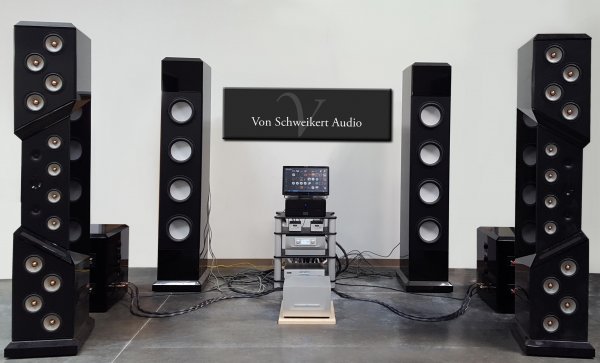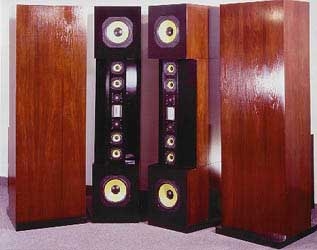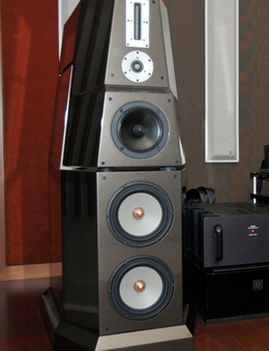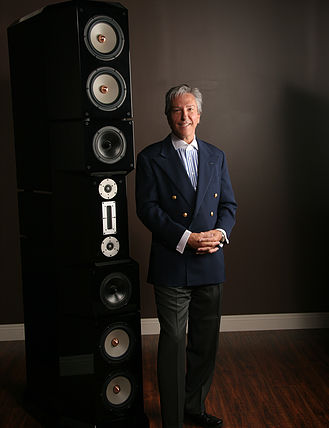
Custom designed ULTRA VR-111XS six tower system. This is not a production model and will never be duplicated.
Hello Fellow Audiophiles,
It is with great pleasure to join this enlightened group of music lovers. Leif and I are here to answer any and all questions about our line of Von Schweikert and Endeavor speaker systems.
We have been in business since 1976, when I developed the VR-4 (originally called the Vortex Screen) and began research on our first four tower system, the VR-10. In 1992, we showed the VR-10 at CES, which was called the "Armageddon" by Guy Lemco of Stereophile. He awarded it Best Sound Of The CES Show. The term "armageddon" was his way to state that "it would be the last speaker you would ever need."

VR-10 Designed by Albert Von Schweikert, released at CES 1992
In 1994, Damon and I developed a small product line, I was the system designer responsible for driver and crossover design. Damon's job was cabinet and industrial design for the VR-4.5, VR-6 and VR-8. The VR-4 remained "as is," as it had become a classic, selling in the thousands. At one time we had 342 dealers selling this model.
The VR-4 went on to win 7 Product Of The Year awards from audio magazines world-wide, and in 2012, it was listed as "One Of The 25 Best Speakers Of All Time" by Audio Review. The list was formed by a survey of several hundred readers of their publication.
The VR-10 was replaced by our VR-11 in 2004, and a smaller version VR-9 was also released. These two flag ships used technology I had been developing over a 30 year period and in 2008, my son Damon Von Schweikert, Leif Swanson, and I reengineered both models to the Mk2 series. Major changes to every single part of the systems elevated the 9Mk2 and 11Mk2 to a level far above the originals.


Although the one-off VR-111XS ULTRA six tower system will never again be duplicated, the technology that Leif, Damon and I developed for the 111 will appear in our revised ULTRA 9, 11, and 101XS models. Our new ULTRA 101XS will be slightly smaller than the VR-111XS ULTRA and will be a production model. As more than a dozen seasoned audiophiles have proclaimed the VR-111XS ULTRA to be the "reference standard" of their experience, we believe the ULTRA 9, 11, and 101 will also become reference standards for many other audiophiles and music lovers.
All of these three systems will feature proprietary ceramic honeycomb drivers made in Germany, Duelund/Jensen oil filled caps, our Pat.Pend. Triple Wall "active" noise reducing cabinet, and most significantly, will use ULTRA alloy internal wiring by Master-Built. A division of a major aerospace company, Master-Built is a U.S. supplier of wiring harnesses used by NASA, CERN, laboratory and military clients. VSA has secured a distribution contract for this product as it is the best measuring (and sounding) cable we have ever tried. In fact, this brand of cables has been used by us and Constellation to win many Best Of Show awards in the past three years.
This November 25-27, the ULTRA 11 will debut at the Singapore Show. Our great distributor there, Bobby of AudioLine, has secured one of the large ballrooms at the hotel and will be playing vinyl, tape, and digital. If you will be in or close to Singapore, come by to meet our designers and hear the ULTRA 11's.
Next year, we will show the ULTRA 11's in Chicago and venues around the world. As we have even more orders for the ULTRA 9's, you can expect to hear these as well. We intend to beef up our presence at US shows while we continue to expand our dealer base around the world. In fact, we have just shipped our 4th pair of flag ships to Dubai.
We thank Steve Williams and Ron Resnick for asking us to become active on this great Forum. After studying the topics on discussion here, we at VSA and Endeavor are proud to be members. If you have questions about our products, do not hesitate to contact Leif Swanson at our Sales Office or just write a post with your question.
As Always, Happy Listening!
Last edited:


